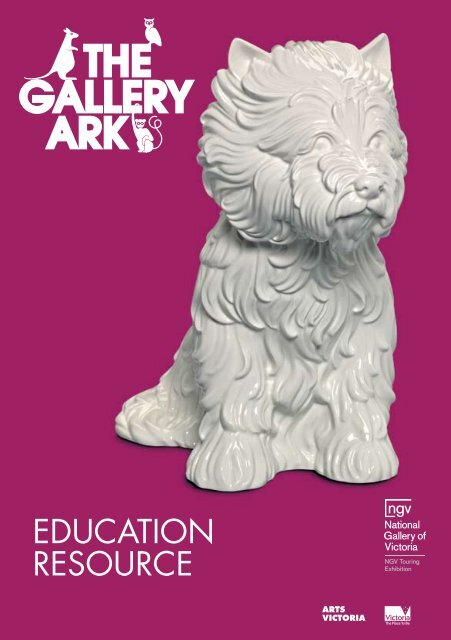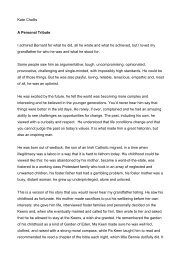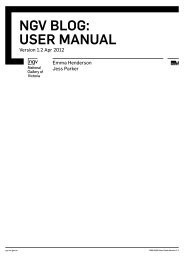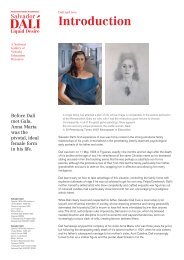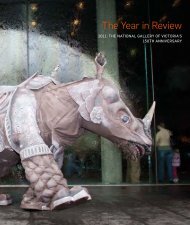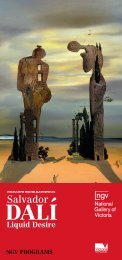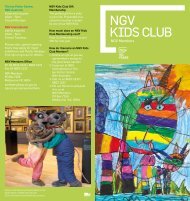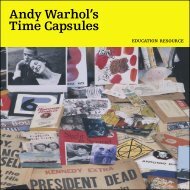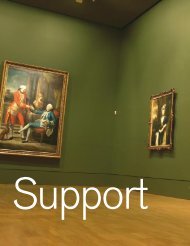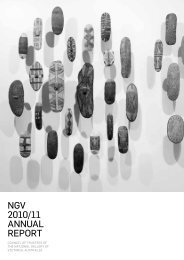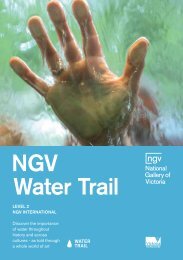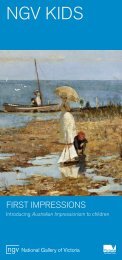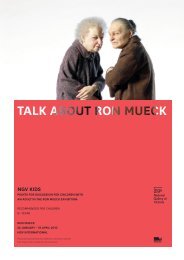EDUCATION RESOURCE - National Gallery of Victoria
EDUCATION RESOURCE - National Gallery of Victoria
EDUCATION RESOURCE - National Gallery of Victoria
Create successful ePaper yourself
Turn your PDF publications into a flip-book with our unique Google optimized e-Paper software.
<strong>EDUCATION</strong><br />
<strong>RESOURCE</strong><br />
<strong>EDUCATION</strong> <strong>RESOURCE</strong> 1
Septimus Power<br />
born New Zealand 1877,<br />
arrived Australia 1880s,<br />
lived in France 1905–07,<br />
England 1907–13,<br />
1915–21, died 1951<br />
The parrot house c.1925<br />
oil on canvas<br />
92.8 x 74.3 cm<br />
Felton Bequest, 1928<br />
Curriculum rationale<br />
This resource connects the <strong>Victoria</strong>n Essential Learning Standards P-10<br />
curriculum <strong>of</strong> the Department <strong>of</strong> Education and Early Childhood Development<br />
with the Discipline Based Learning: Science; the Physical, Personal and Social<br />
Learning Domain: Civics and Citizenship; and the Art Dimension: Exploring<br />
and Responding.<br />
The resource aims to link art, science and thinking through the exploration <strong>of</strong><br />
works <strong>of</strong> art, with a focus on animals and interactions, within the environment,<br />
with people and each other, to explore ethical principles in respect to animals,<br />
and to assist students to develop values systems in response to animals.<br />
A focus on animal inspirations will explore works <strong>of</strong> art inspired by animals, to<br />
understand symbolism, iconography, style, possible religious and mythological<br />
narrative, the range <strong>of</strong> cultures represented over time, from ancient to modern,<br />
and the diversity <strong>of</strong> materials and techniques used in the making <strong>of</strong> works <strong>of</strong> art.<br />
A focus on animal interpretations will explore works <strong>of</strong> art to construct<br />
meanings and messages, to develop and refine students’ art language and visual<br />
analysis skills, and to introduce interpretive frameworks and thinking skills.<br />
Throughout this exhibition, The <strong>Gallery</strong> Ark, students are encouraged to<br />
compare and contrast images and objects <strong>of</strong> the diverse animals depicted.<br />
COVER<br />
Jeff Koons (designer)<br />
born United States 1955<br />
Puppy, vase 1998<br />
porcelain<br />
44.6 x 27.9 x 44.8cm<br />
Purchased, 2004<br />
© Jeff Koons, courtesy <strong>of</strong><br />
Gagosian <strong>Gallery</strong>, New York<br />
Animal interpretations<br />
Biographical reference<br />
Septimus Power was born in Dunedin, New Zealand in<br />
1877, and soon after his family migrated to Australia,<br />
settling in Melbourne. At the age <strong>of</strong> fourteen, Power<br />
ran away from home to pursue a career as an artist.<br />
He developed a passion for drawing horses and other<br />
animals. While working for a carriage painter, he painted<br />
studies <strong>of</strong> animal heads onto butcher’s delivery vans, and<br />
he later worked as an assistant to a vet.<br />
Septimus Power is more well known for his First World<br />
War paintings <strong>of</strong> horses, which he produced for the<br />
Australian War Memorial. Power was given the honorary<br />
rank <strong>of</strong> lieutenant and was an <strong>of</strong>ficial war artist from<br />
September to December 1917, and again from August<br />
1918 to March 1920.<br />
Materials and techniques<br />
Examine the composition. Is there evidence to suggest<br />
that the artist has constructed this painting from his<br />
imagination rather than painting from life?<br />
Issues for discussion<br />
• Can you identify the types <strong>of</strong> birds<br />
depicted in this painting?<br />
• What is your opinion about keeping<br />
caged birds?<br />
• The Norfolk Island parakeet,<br />
Orange-bellied parakeet, Scarletchested<br />
parakeet, and the Turquoise<br />
parakeet are all endangered species<br />
<strong>of</strong> Australia. Find out more about<br />
endangered birds in Australia.<br />
• This work was purchased through<br />
the Felton Bequest in 1928 under<br />
the advice <strong>of</strong> the <strong>National</strong> <strong>Gallery</strong><br />
<strong>of</strong> <strong>Victoria</strong> director, Bernard Hall,<br />
who was very supportive <strong>of</strong> Power’s<br />
work. Find out more about Alfred<br />
Felton and his bequest to the<br />
<strong>National</strong> <strong>Gallery</strong> <strong>of</strong> <strong>Victoria</strong>.<br />
<strong>EDUCATION</strong> <strong>RESOURCE</strong> 1
Symbolism<br />
Birds are <strong>of</strong>ten a symbol <strong>of</strong> enlightenment, perspective,<br />
swiftness, vision, and prophetic knowledge.<br />
Compare and contrast<br />
Find Murray Griffin’s linocut <strong>of</strong> the cockatoo, The white<br />
one 1933 and compare the style with the work <strong>of</strong><br />
Septimus Power.<br />
Murray Griffin<br />
Australia 1903–1992<br />
The white one 1933<br />
colour linocut, ed. 6/12<br />
20.8 x 35.5 cm (block);<br />
33.2 x 39.7 cm (sheet)<br />
Felton Bequest, 1934<br />
© Courtesy <strong>of</strong> the artist’s<br />
estate<br />
Did you know?<br />
The parrot family includes cockatoos,<br />
lorikeets, rosellas, ringnecks and<br />
budgerigars. Illegal trapping and<br />
smuggling operations <strong>of</strong> live birds<br />
may have contributed to the decrease<br />
in Australian parrot populations, but<br />
the removal <strong>of</strong> eggs from their nests<br />
poses a bigger threat. This is because<br />
nest-robbers <strong>of</strong>ten destroy the birds’<br />
nesting hollow, making it unavailable<br />
for the next breeding season. It is<br />
easier to obtain and transport eggs<br />
than adult birds, and far greater<br />
numbers can be smuggled from the<br />
country and distributed overseas by<br />
this means.<br />
Animal Interactions<br />
Biographical reference<br />
Audrey Flack was born in New York and attended music<br />
and art school before going onto study at Cooper Union,<br />
New York in the early 1950s. She began her career as an<br />
abstract artist studying under Josef Albers (1888–1976) at<br />
Yale University, Connecticut, where she graduated in 1953.<br />
In 1965, Flack painted her first portrait based on a<br />
photograph, imitating its colour and appearance. Her use <strong>of</strong><br />
this technique isolated her from the art community at a time<br />
when abstract art, minimalism, conceptual art, process art<br />
and body art were considered to be avant-garde.<br />
Materials and techniques<br />
List the elements <strong>of</strong> art. Why are they important in making<br />
a work <strong>of</strong> art?<br />
Look at the surface <strong>of</strong> the painting carefully. What<br />
process do you think the artist has used to create this<br />
painting? How has the paint been applied?<br />
Comment on the use <strong>of</strong> composition.<br />
Comment on the use <strong>of</strong> colour, in particular the use <strong>of</strong> blue.<br />
What evidence is there to suggest Flack has used<br />
photography as a source?<br />
Find out more about the style <strong>of</strong> photo-realism.<br />
Audrey Flack<br />
born United States 1931<br />
Parrots live forever 1978<br />
oil and synthetic polymer<br />
paint on canvas<br />
211.2 x 211.2 cm<br />
Purchased through<br />
The Art Foundation<br />
<strong>of</strong> <strong>Victoria</strong> with the<br />
assistance <strong>of</strong> Esso<br />
Australia Ltd, Fellow,<br />
1978<br />
© Courtesy <strong>of</strong> the artist<br />
Did you know?<br />
Vanitas is related to the word<br />
vanity and refers to transience.<br />
The term comes from the opening<br />
verse <strong>of</strong> Ecclesiastes in the Latin<br />
Bible (Vulgate), ‘Vanitas vanitatum,<br />
omnia vanitas’ (vanity <strong>of</strong> vanities,<br />
all is vanity). What do you think this<br />
means?<br />
Issues for discussion<br />
• In the sixteenth and seventeenth<br />
centuries in northern Europe,<br />
painters commonly created symbolic<br />
still-life paintings known as vanitas.<br />
Find out more about this type<br />
<strong>of</strong> painting and the symbolism<br />
associated with this tradition.<br />
• Which objects in this painting make<br />
reference to the transient nature <strong>of</strong><br />
life?<br />
• Do you think the artist has taken<br />
any liberties with this tradition? How<br />
has she interpreted vanitas in a<br />
modern context?<br />
• Why do you think the artist has<br />
chosen this particular title? What do<br />
you think she might be suggesting?<br />
Symbolism<br />
Consistent through Flack’s career is<br />
her emphasis on symbolism as well<br />
as the surface materiality <strong>of</strong> paint.<br />
Find out more about the symbolism in<br />
this painting.<br />
2 THE GALLERY ARK <strong>EDUCATION</strong> <strong>RESOURCE</strong> 3
Animal Interactions<br />
Biographical reference<br />
Wu Zuoren had a very distinguished academic and<br />
artistic career as a painter <strong>of</strong> both traditional Chinese<br />
painting and also western painting in oil. From 1927–31<br />
he studied in Shanghai, Nanjing, France and Belgium<br />
and returned to China in 1935 to lecture in Nanjing.<br />
During the war he moved to Shanghai and organised the<br />
Shanghai Artists’ Association. Later Wu Zuoren became<br />
pr<strong>of</strong>essor at the Beijing Academy and one <strong>of</strong> China’s<br />
leading artists.<br />
Materials and techniques<br />
Research other Chinese ink and brush paintings to learn<br />
more about this technique.<br />
Describe the various techniques you think the artist may<br />
have used to manipulate the ink and brush to create the<br />
image <strong>of</strong> the panda.<br />
Find out why the artist has included calligraphy and the<br />
red seal.<br />
Issues for discussion<br />
• Pandas face a number <strong>of</strong> threats, including poaching by<br />
humans. Their habitats are also sporadic and populations<br />
are small and isolated from one another. What do you<br />
think could be done to assist in the conservation <strong>of</strong> the<br />
giant panda?<br />
• Do you think there is any<br />
significance in the underlying<br />
symbolism <strong>of</strong> the panda and the<br />
traditional contemplative nature and<br />
purpose <strong>of</strong> scroll painting?<br />
Symbolism<br />
The panda is considered a symbol<br />
<strong>of</strong> peace in China and as such was<br />
chosen as one <strong>of</strong> the mascots <strong>of</strong> the<br />
2008 Beijing Olympics, to symbolise<br />
the aspiration for a peaceful and<br />
harmonious world.<br />
Did you know?<br />
Wu Zuoren<br />
China 1908–1997<br />
Pandas and bamboo<br />
1964<br />
album: ink on paper, 8<br />
paintings, cardboard,<br />
paper, silk and gold leaf<br />
on concertina glued<br />
binding<br />
31.7 x 22.0 cm (image<br />
and sheet) (each); 31.8 x<br />
22.6 x 2.0 cm (closed);<br />
31.8 x 45.2 x 1.0 cm<br />
(open)<br />
Gift <strong>of</strong> an anonymous<br />
donor, 2007<br />
© Estate <strong>of</strong> the artist<br />
There are approximately 1,600 giant<br />
pandas estimated as still living in the<br />
wild. Giant pandas are classified as<br />
bears and may consume 12–38kg<br />
<strong>of</strong> bamboo every day to meet their<br />
energy requirements.<br />
Animal Inspirations<br />
Biographical reference<br />
Francois Pompon was born in Saulieu in Burgundy and is<br />
primarily known for his animal sculptures <strong>of</strong> the twentieth<br />
century. After his initial studies in Dijon and Paris, Pompon<br />
made his living as a sculptor’s assistant and in this<br />
capacity he served many <strong>of</strong> the prominent sculptors <strong>of</strong> his<br />
day. Pompon worked for over fifteen years with Auguste<br />
Rodin (1840–1917), translating his clay figures into<br />
marble carving.<br />
Materials and techniques<br />
This is a rare bronze version <strong>of</strong> Pompon’s first large-scale<br />
Polar bear. The work was formed from an initial clay<br />
model which was then cast in plaster. The original is now<br />
in the Musée d’Orsay in Paris.<br />
A plaster model <strong>of</strong> Polar bear was exhibited at the<br />
Salon d’Automne in 1922 and again in the 1925 Paris<br />
Exhibition Internationale des Arts Décoratifs et Industriels<br />
Modernes. Research these two important events and<br />
discover why they were significant occasions.<br />
Issues for discussion<br />
• Pompon modelled this sculpture<br />
in 1927. What may have made his<br />
sculpture so popular with so many<br />
people at this time?<br />
• Why do you think the polar bear<br />
fascinated the artist?<br />
Did you know?<br />
Polar bears are endangered due to<br />
climate change and pollution. Their<br />
Arctic habitat is melting and they risk<br />
starvation.<br />
Polar bears are also mercilessly killed<br />
by trophy hunters who are willing to<br />
pay large sums <strong>of</strong> money to shoot<br />
them. What other animals do you<br />
know that may be at risk from these<br />
causes?<br />
Symbolism<br />
Generally bears are a symbol<br />
<strong>of</strong> gentle strength, dreaming,<br />
introspection, power and protection.<br />
In recent times the polar bear has<br />
become a symbol <strong>of</strong> global warming.<br />
Compare and contrast<br />
Find Auguste Rodin’s The crying<br />
lion and compare it with Pompon’s<br />
sculpture. Is there any evidence that<br />
Pompon was influenced by Rodin in<br />
the making <strong>of</strong> his work?<br />
(Top)<br />
François Pompon<br />
France 1855–1933<br />
Claude Valsuani, Paris<br />
(foundry)<br />
France 1909–1979<br />
Polar bear<br />
(Ours blanc)<br />
(1927, cast c.1933)<br />
bronze<br />
24.2 x 44.3 x 11.6cm<br />
Purchased with the<br />
assistance <strong>of</strong> the<br />
proceeds <strong>of</strong> the 2008<br />
<strong>National</strong> <strong>Gallery</strong> <strong>of</strong><br />
<strong>Victoria</strong> Annual Dinner,<br />
2007<br />
(Left)<br />
Auguste Rodin<br />
France 1840–1917<br />
The crying lion<br />
(Le lion qui pleure)<br />
1881<br />
bronze<br />
34.4 x 35.5 x 16.9 cm<br />
(overall)<br />
Felton Bequest, 1909<br />
4 THE GALLERY ARK <strong>EDUCATION</strong> <strong>RESOURCE</strong> 5
Nepal<br />
Ganesha<br />
(17th century)<br />
copper, gold<br />
12.3 x 8.5 x 6.2 cm<br />
Presented through<br />
The Art Foundation <strong>of</strong><br />
<strong>Victoria</strong> by Sir James<br />
Plimsoll, AC CBE,<br />
Governor, 1982<br />
Frederick McCubbin<br />
Australia 1855–1917<br />
A winter evening 1897<br />
oil on canvas<br />
120.8 x 151.2 cm<br />
Purchased, 1900<br />
Early and impermanent images <strong>of</strong><br />
paste and clay were replaced with<br />
those <strong>of</strong> a permanent material,<br />
describing the deity and his powers<br />
as actively as possible. Bronze<br />
images <strong>of</strong> Ganesha were also cast in<br />
southern India for use as images in<br />
temple festivals and processions.<br />
Issues for discussion<br />
Animal Interpretations<br />
Historical reference<br />
The elephant-headed god Ganesha is the son <strong>of</strong> Shiva<br />
(one <strong>of</strong> the many gods associated with Hinduism)<br />
and his consort, the goddess Parvati, and is the chief<br />
<strong>of</strong> their dwarf attendants (the ganas). Also known as<br />
Vighneshvara or Vinayaka (the Remover <strong>of</strong> Obstacles), he<br />
is worshipped at the beginning <strong>of</strong> all ventures, especially<br />
starting a business or buying a vehicle. Ganesha is<br />
a popular figure in Indian art and was particularly<br />
worshipped by traders and merchants. As one <strong>of</strong> the<br />
most popular Hindu gods worshipped today, statues<br />
<strong>of</strong> Ganesha can be found in Java, Borneo, Bali, Burma,<br />
Cambodia and Thailand.<br />
Materials and techniques<br />
Ganesha is also referred to as the God <strong>of</strong> Good Fortune.<br />
The Hindu use <strong>of</strong> the image was first <strong>of</strong> all an aid to<br />
contemplation, a way <strong>of</strong> achieving identification with the<br />
deity.<br />
• What is it about the properties <strong>of</strong><br />
bronze that make it an ideal material<br />
for use in sculpture?<br />
Did you know?<br />
There are several versions <strong>of</strong> how<br />
Ganesha came to have an elephant<br />
head. In one version, after Shiva<br />
cut <strong>of</strong>f Ganesha’s head in a rage,<br />
Parvati pleaded to have him revived.<br />
Shiva agreed to have his son’s head<br />
replaced by the first creature to<br />
walk by – which happened to be an<br />
elephant.<br />
Symbolism<br />
Often Ganesha is depicted standing<br />
on a rat or mouse. This is his vehicle<br />
or carrier. The rat is also capable <strong>of</strong><br />
gnawing through obstacles, which<br />
mirrors Ganesha’s ability to facilitate<br />
action.<br />
Research the symbolism associated<br />
with Ganesha and the snake. What<br />
other important symbols can you<br />
find?<br />
Animal Interpretations<br />
Biographical reference<br />
Frederick McCubbin was born in Melbourne and the<br />
subject <strong>of</strong> his art was firmly located in the city and<br />
surrounding landscape. Throughout his life McCubbin<br />
retained close links with the <strong>National</strong> <strong>Gallery</strong> <strong>of</strong> <strong>Victoria</strong>,<br />
acting in the capacity <strong>of</strong> director on several occasions.<br />
From 1886 until his death McCubbin was the drawing<br />
master at the NGV <strong>Gallery</strong> School where he influenced<br />
both his peers and the younger artists <strong>of</strong> his generation.<br />
His career spanned a period <strong>of</strong> strong development<br />
in Australian art from pioneering and heroic subjects,<br />
with their focus on identity, to the height <strong>of</strong> Australian<br />
Impressionism.<br />
After his first overseas trip in 1907, McCubbin’s themes<br />
remained classically inspired, but his paintings became<br />
freer, more fluidly painted works with their exploratory<br />
bursts <strong>of</strong> colour, light and texture.<br />
Materials and techniques<br />
In your analysis <strong>of</strong> the composition, what conventions or<br />
traditions has McCubbin adhered to?<br />
Describe the use <strong>of</strong> colour.<br />
What methods do you think<br />
McCubbin has employed to apply the<br />
paint?<br />
What time <strong>of</strong> day and season are<br />
indicated in the painting?<br />
What mood is suggested and evoked<br />
by the time <strong>of</strong> day and season?<br />
Issues for discussion<br />
• The artist was fascinated by the<br />
work <strong>of</strong> the French artist Jules<br />
Bastien-Lepage (1848–1884).<br />
Research a work in the collection <strong>of</strong><br />
the <strong>National</strong> <strong>Gallery</strong> <strong>of</strong> <strong>Victoria</strong> by<br />
this artist, and compare and contrast<br />
the methods and intentions <strong>of</strong> both<br />
artists.<br />
6 THE GALLERY ARK <strong>EDUCATION</strong> <strong>RESOURCE</strong> 7
Symbolism<br />
Light has <strong>of</strong>ten existed in art as a metaphor for the<br />
journey <strong>of</strong> life and also the presence <strong>of</strong> God. In fact, J. M.<br />
W. Turner (1775–1851), who inspired McCubbin, was<br />
reputed to have said on his deathbed, ‘God is light’.<br />
Ducks and geese have been associated with fertility in<br />
Ancient Egypt and Pre-Columbian history. In Christian<br />
iconography ducks are symbolic <strong>of</strong> adoration and<br />
constancy, and in Korea and China, ducks and geese are<br />
seen as symbols <strong>of</strong> faithfulness and wedded bliss.<br />
Compare and contrast<br />
Look closely at Charles Conder’s interpretation, The farm,<br />
Richmond, New South Wales 1888.<br />
What are the similarities in the depiction <strong>of</strong> subject<br />
matter? What are the differences?<br />
Compare the composition <strong>of</strong> both paintings. What do you<br />
notice?<br />
Did you know?<br />
Some <strong>of</strong> the other major artists<br />
associated with Australian<br />
Impressionism were Charles Conder<br />
(1860–1940), Arthur Streeton<br />
(1867–1943), Tom Roberts<br />
(1956–1931), Clara Southern<br />
(1860–1940), and Jane Sutherland<br />
(1853–1928).<br />
En plein air is a French term meaning<br />
‘in the open air’. In art it is used to<br />
describe the practice <strong>of</strong> working out<br />
<strong>of</strong> doors rather than in the studio.<br />
Charles Conder<br />
England 1868–1909,<br />
lived in Australia<br />
1884–90<br />
The farm, Richmond,<br />
New South Wales 1888<br />
oil on paper on canvas<br />
45.0 x 50.7 cm irreg.<br />
(image); 45.4 x 51.3 cm<br />
(canvas)<br />
Purchased with<br />
the assistance <strong>of</strong> a<br />
special grant from the<br />
Government <strong>of</strong> <strong>Victoria</strong>,<br />
1979<br />
Animal Interactions<br />
Biographical reference<br />
In 1886 Conder joined the Art Society <strong>of</strong> New South<br />
Wales. In the same year he left his apprenticeship as a<br />
surveyor. Conder’s first sketching expedition to Richmond<br />
was documented in a small leather-bound book <strong>of</strong><br />
watercolour sketches inscribed with his name and<br />
address, along with the date <strong>of</strong> commencement,<br />
17 May 1887.<br />
After meeting Tom Roberts in Sydney in autumn 1888,<br />
Conder moved to Melbourne where he made a significant<br />
impact in the art world as part <strong>of</strong> the group <strong>of</strong> artists now<br />
known as the Australian Impressionists.<br />
Materials and techniques<br />
Conder was introduced to the idea <strong>of</strong> painting landscape<br />
out <strong>of</strong> doors. This was largely due to the influence <strong>of</strong><br />
Julian Ashton (1851–1942) who also painted in the<br />
Hawkesbury region, and Conder’s instructor A. J. Daplyn<br />
(1844–1926) who had both trained in London and<br />
pursued studies in Paris.<br />
Describe the light, colour and use <strong>of</strong> atmospheric effects<br />
in Conder’s painting.<br />
Issues for discussion<br />
• Identify the animals represented in the painting. Notice<br />
the broken fence. What might keep this disparate group<br />
<strong>of</strong> animals from escaping their enclosure?<br />
Symbolism<br />
Did you know?<br />
Together with Arthur Streeton, Tom<br />
Roberts and other painters, Conder<br />
spent the summers <strong>of</strong> 1888–89 and<br />
1889–90, as well as many weekends,<br />
painting near Eaglemont, Heidelberg.<br />
He was affectionately nicknamed ‘K’<br />
and exhibited with his friends in the<br />
9 by 5 Impression Exhibition held in<br />
the Buxton Galleries, Melbourne, in<br />
1889. He left Melbourne in 1890 and<br />
travelled via London to Paris where<br />
he embraced the bohemian lifestyle<br />
and met artists like Toulouse-Lautrec.<br />
The beauty and poignancy <strong>of</strong> the fragile blossom in<br />
Conder’s painting are interesting to consider. Blossom<br />
is also a favourite theme in Japanese works <strong>of</strong> art,<br />
particularly woodblock prints, and cherry blossom is<br />
Japan’s national flower. The fleeting and fragile nature <strong>of</strong><br />
their beauty suggests purity and transience. They can be<br />
seen as symbols <strong>of</strong> death and mortality. Japanese pilots<br />
during the Second World War painted blossom (sakura)<br />
on the side <strong>of</strong> their planes before embarking on a suicide<br />
mission.<br />
8 THE GALLERY ARK <strong>EDUCATION</strong> <strong>RESOURCE</strong> 9
Animal Inspirations<br />
Did you know?<br />
The influential French Academy<br />
organised a regular exhibition <strong>of</strong> art.<br />
By the nineteenth century, the Paris<br />
Salon exhibition was held annually<br />
and included thousands <strong>of</strong> works<br />
<strong>of</strong> art. The exhibitions generated<br />
enormous critical, public and media<br />
interest, and crowds <strong>of</strong> up to 50,000<br />
people attended daily.<br />
Biographical reference<br />
Jeff Koons was born in York, Pennsylvania. When he was<br />
a teenager he was invited to meet the artist Salvador Dali<br />
(1904–1989) whom he admired. Later Koons studied<br />
at the Maryland College <strong>of</strong> Art and the Art Institute <strong>of</strong><br />
Chicago. He first gained recognition in the early 1980s,<br />
and subsequently set up a factory-like studio employing<br />
a number <strong>of</strong> assistants in a similar vein to Andy Warhol<br />
(1928–1987) and Damien Hirst (b. 1965) today.<br />
In the 1990s Koons started to work on giant sculptures<br />
and in 1992 he was commissioned to make a piece in<br />
Kassell, Germany, which resulted in the first <strong>of</strong> a series<br />
<strong>of</strong> large-scale puppies: a 12.4 metre tall West Highland<br />
white terrier puppy made as topiary. Later this work was<br />
purchased to be installed in Bilbao, Spain, by the Solomon<br />
R. Guggenheim Foundation and Museum.<br />
In 1996 the giant Puppy was exhibited at the Museum<br />
<strong>of</strong> Contemporary Art in Sydney as part <strong>of</strong> the Festival <strong>of</strong><br />
Sydney and to celebrate the twenty-fifth year <strong>of</strong> John<br />
Kaldor Art Projects.<br />
Violet Teague<br />
Australia 1872–1951<br />
Cynthia and Count<br />
Brusil<strong>of</strong>f (1917)<br />
oil on canvas<br />
201.2 x 131.8 cm<br />
Purchased, 1954<br />
Materials and techniques<br />
In a letter from her great-niece<br />
Felicity Druce, it is documented that<br />
Teague painted this picture with only<br />
eight sittings <strong>of</strong> her younger cousin<br />
Cynthia posing as the page boy.<br />
Druce wrote that Count Brusil<strong>of</strong>f, the<br />
dog, ‘belonged to a Miss Carrighan<br />
who duly arrived to take him for a<br />
walk every hour’.<br />
This painting was awarded a Silver<br />
medal when it was exhibited at the<br />
Paris Salon and it eventually became<br />
the property <strong>of</strong> Cynthia before it was<br />
purchased for the <strong>National</strong> <strong>Gallery</strong> <strong>of</strong><br />
<strong>Victoria</strong> collection in 1954.<br />
Issues for discussion<br />
Materials and techniques<br />
Koons’s work draws from art history, popular culture and<br />
kitsch. This object made from porcelain reflects Koons’s<br />
recurring interest in the puppy as a subject and his earlier<br />
themes <strong>of</strong> porcelain toys. How important do you think the<br />
scale <strong>of</strong> a sculptural work is?<br />
Jeff Koons (designer)<br />
born United States 1955<br />
Puppy, vase 1998<br />
porcelain<br />
44.6 x 27.9 x 44.8 cm<br />
Purchased, 2004<br />
© Jeff Koons, courtesy<br />
<strong>of</strong> Gagosian <strong>Gallery</strong>,<br />
New York<br />
Did you know?<br />
Koons registered his giant topiary<br />
Puppy, 1996, with the Sydney City<br />
Council while it was on exhibition<br />
there.<br />
John Kaldor has made a significant<br />
impact on Australian art by bringing<br />
contemporary art and artists to this<br />
country. Research John Kaldor Art<br />
Projects for further information.<br />
Animal Interpretations<br />
Biographical reference<br />
Violet Teague was born in Melbourne and was educated<br />
by a French governess and at the Presbyterian Ladies<br />
College. Later she had the opportunity to travel to Europe<br />
and studied art in Brussels and England.<br />
When she returned to Melbourne in 1896, Teague joined<br />
evening classes at the <strong>National</strong> <strong>Gallery</strong> School studying<br />
under Bernard Hall (1859–1935), and also attended the<br />
Melbourne School <strong>of</strong> Art led by Emmanuel Phillips Fox<br />
(1865–1915).<br />
Teague exhibited regularly at the <strong>Victoria</strong>n Artists Society<br />
and, although she is most well known for her portraits<br />
<strong>of</strong> family and friends, she was an exceptional painter <strong>of</strong><br />
animal portraits.<br />
• Can you identify the type <strong>of</strong> dog in<br />
the painting? Why do you think the<br />
artist chose this breed <strong>of</strong> dog?<br />
Symbolism<br />
Dogs have been associated with<br />
loyalty and friendship, faithfulness<br />
and guardianship, courage and<br />
vigilance.<br />
Compare and contrast<br />
Teague admired the painter Thomas<br />
Gainsborough (1727–1788) and<br />
in particular his famous Blueboy,<br />
c.1770. Research this painting to find<br />
the stylistic similarities.<br />
Issues for discussion<br />
• Koons has <strong>of</strong>ten suggested that he is not interested<br />
in the question <strong>of</strong> good or bad art. He would prefer<br />
to make art which evokes a response or emotion. He<br />
believes that Puppy communicates happiness and<br />
makes people feel good, and that it is optimistic. What<br />
do you think about this reasoning?<br />
• One <strong>of</strong> Koons’s earlier influences was the artist Salvador<br />
Dalí. What do you think Koons might have admired<br />
about Dalí? Do you think it was his painting or his public<br />
persona? Give reasons for your answer.<br />
Symbolism<br />
Research if there is any special<br />
symbolism attached to particular<br />
breeds <strong>of</strong> dogs.<br />
10 THE GALLERY ARK <strong>EDUCATION</strong> <strong>RESOURCE</strong> 11
Animal Interpretations<br />
Biographical reference<br />
Dick Pantimas Tjupurrula was born at Yippa, north <strong>of</strong><br />
Sandy Blight Junction, near the Northern Territory and<br />
Western Australia border. He was identified as the twoyear-old<br />
infant ‘Pandimatu’ by Norman Tindale at Mt<br />
Liebig in 1932. He was the younger brother <strong>of</strong> great<br />
Papunya Tula artist Johnny Warangkula Tjupurrula<br />
(c.1925–2001), with whom he shared the Kalimpinpa<br />
water story and other Dreamings. He came with his family<br />
to Hermannsburg mission before the Second World War<br />
and he was recorded as a stockman at Haasts Bluff in<br />
1957.<br />
Dick Pantimas Tjupurrula later moved to Papunya and<br />
was one <strong>of</strong> the original shareholders <strong>of</strong> Papunya Tula<br />
Artists. He began to paint in earnest for Andrew Crocker<br />
in 1980, working mainly on small-scale canvases. Many<br />
<strong>of</strong> his works depicted the Kalimpinpa water story, also his<br />
Dreaming. Tjupurrula died in 1983, before his career had<br />
time to blossom.<br />
Materials and techniques<br />
A modern art movement began at Papunya in central<br />
Australia in 1971, when Aboriginal men from the Western<br />
Desert were first encouraged to paint their stories with<br />
new materials. Ge<strong>of</strong>frey Bardon, a school teacher at<br />
Papunya community school, asked his students to paint<br />
a mural on the school walls, using ceremonial body and<br />
sand designs. Eventually a number <strong>of</strong> senior men came<br />
together to create a historic mural depicting the Honey<br />
Ant Dreaming associated with the Papunya community.<br />
The mural, a proud symbol <strong>of</strong> Aboriginal culture, inspired<br />
other senior men to start painting. They took discarded<br />
materials from the settlement – fruit box ends, floor tiles,<br />
scraps <strong>of</strong> board – and unlocked ancient designs that until<br />
1971 had been kept hidden from the uninitiated. The<br />
following year, the founding artists, keen to sell their work,<br />
formed their own company. Papunya Tula Artists Pty Ltd<br />
has operated successfully as an independent business<br />
ever since. Papunya Tula artists have transformed the way<br />
we see the land and the history <strong>of</strong> art in this country. Due<br />
to the ‘big bang’ effect <strong>of</strong> the Papunya Tula movement,<br />
Aboriginal art, in all its diverse forms, has become the<br />
mainstream <strong>of</strong> Australian contemporary art practice and<br />
has leapt onto the international stage.<br />
Issues for discussion<br />
• Contrary to common perception,<br />
Aboriginal art is dynamic and has<br />
never been static. The complex<br />
meanings in Aboriginal art and its<br />
many different styles provide an<br />
opportunity to learn more about<br />
Aboriginal culture. Compare other<br />
diverse Aboriginal styles through the<br />
exhibition The <strong>Gallery</strong> Ark<br />
Symbolism<br />
Throughout the Western Desert,<br />
ancestral beings emerged from<br />
the body <strong>of</strong> the land and travelled<br />
extensively. During their epic<br />
Dreaming journeys, ancestral beings<br />
created sources <strong>of</strong> water and other<br />
natural features, established laws for<br />
Aboriginal people to follow, and then<br />
entered into and became the land,<br />
leaving their spiritual power in the<br />
landscape.<br />
In Serpent Dreaming at Yippa 1983<br />
the artist depicts the creation story<br />
<strong>of</strong> his birthplace, Yippa, a small salt<br />
lake. Two great serpents came to<br />
Yippa from the east and began to<br />
fight. So fierce was their battle that<br />
it excavated the lake bed. One <strong>of</strong> the<br />
snakes was overpowered and it can<br />
be seen to this day in the form <strong>of</strong> a<br />
long, low and rocky hill: its head is a<br />
jutting rock. The other snake carried<br />
on westwards. In this painting the<br />
lake is shown with the snake and the<br />
abundant vegetation associated with<br />
water. The dark patches around the<br />
salt lake represent claypans.<br />
Compare and contrast<br />
Find another work in The <strong>Gallery</strong> Ark<br />
that represents a snake.<br />
Did you know?<br />
The name Papunya Tula is derived<br />
from tula, a small hill near Papunya,<br />
which is a Honey Ant Dreaming site.<br />
Dick Pantimas<br />
Tjupurrula<br />
Luritja c.1930–1983<br />
Serpent Dreaming at<br />
Yippa 1980<br />
synthetic polymer paint<br />
on canvas<br />
60.8 x 51.0 cm<br />
Purchased from<br />
Admission Funds, 1988<br />
© Estate <strong>of</strong> the artist,<br />
courtesy <strong>of</strong> Aboriginal<br />
Artists Agency, Sydney<br />
12 THE GALLERY ARK <strong>EDUCATION</strong> <strong>RESOURCE</strong> 13
© <strong>National</strong> <strong>Gallery</strong> <strong>of</strong> <strong>Victoria</strong> 2009<br />
This book is copyright. Apart from any use as permitted<br />
under the Copyright Act 1968, no part may be reproduced<br />
by any process without prior written permission.<br />
Enquiries should be directed to the publisher.<br />
Published by the Council <strong>of</strong> Trustees <strong>of</strong><br />
the <strong>National</strong> <strong>Gallery</strong> <strong>of</strong> <strong>Victoria</strong><br />
180 St Kilda Road<br />
Melbourne <strong>Victoria</strong> 3004<br />
Australia<br />
ngv.vic.gov.au<br />
Text prepared by Paula Lindley<br />
Design: Elizabeth Carey Smith<br />
Photography: NGV Photographic Services<br />
Printing: Blue Star Print<br />
The <strong>Gallery</strong> Ark<br />
A <strong>National</strong> <strong>Gallery</strong> <strong>of</strong> <strong>Victoria</strong> touring exhibition<br />
Mildura Arts Centre<br />
22 January – 18 February 2009<br />
Geelong <strong>Gallery</strong><br />
28 February – 26 April 2009<br />
McClelland <strong>Gallery</strong> + Sculpture Park<br />
10 May – 19 July<br />
Bundoora Homestead Art Centre<br />
7 August 2009 – 13 September 2009<br />
Horsham Regional Art <strong>Gallery</strong><br />
22 December 2009 – 28 February 2010<br />
Program Supporter<br />
Supported by<br />
14 THE GALLERY ARK<br />
Indemnification for this<br />
exhibition is provided by<br />
the <strong>Victoria</strong>n Government<br />
This project is supported by<br />
the <strong>Victoria</strong>n Government<br />
through Arts <strong>Victoria</strong>’s Major<br />
Touring Initiative


